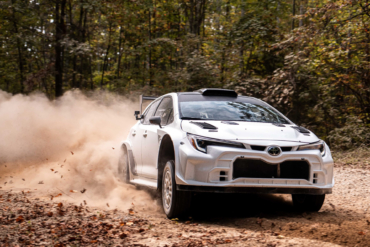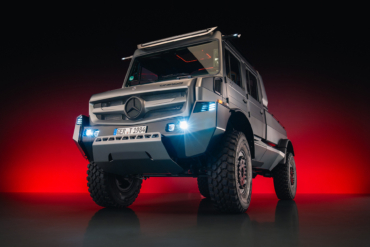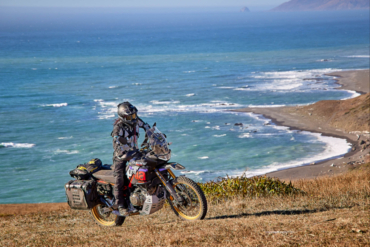Our intro to adventure riding guide will get you rolling on two wheels on the road less traveled without breaking the bank.
First things first — let’s get past the sticker shock. Getting into adventure (or ADV) riding can be intimidating when you see the cost of everything and the list of specialized gear required.
A new adventure bike can easily cost upward of $9,000-20,000 and more if you want all the bells and whistles. A quality set of adventure riding gear will easily set you back over a grand. Add moto luggage, and you can be at $25,000+ before you even roll out of your driveway.
But, fear not! Don’t let this scare you away from the absolute joy of being able to go places that aren’t accessible by larger modes of travel. It is possible to get into the rewarding adventure motorcycling lifestyle without breaking the bank.

Let’s dive into what you really need and how much it’s going to cost.
Adventure Motorcycle

The main ingredient to the ADV moto life is, of course, the bike. Motorcycles meant for riding both on-road and off-road (smaller dual-sport bikes and larger ADV/touring bikes) are certainly going to be able to get you to much more remote places than a street bike.
But, most street bikes are more than capable of taking you across graded and maintained dirt roads, forest service roads, and so on. You can have adventures no matter what you choose to ride or what your wallet allows.
A determined rider can pick up older dual-sport bikes for a couple of thousand dollars, or less in some cases. Depending on the year, make, and model, one can find the larger ADV/touring bikes all day in the $5,000-10,000 range. There are a lot of fantastic bikes out there.

Smaller displacement dual-sport motorcycles are growing in popularity and are much easier on the wallet in most cases. The middleweight and larger ADV classes of bikes from various manufacturers are a staple in the industry. And they’re probably what you imagine when someone says they are an adventure rider.
If you want to save and are handy with a wrench, you can pick up bikes that might need a little TLC to make them a reliable roadworthy companion again, sometimes for only a few hundred dollars. You need to look at what type of riding you plan to do, how good you are at wrenching, and what you can afford.
Adventure Riding Gear
Adventure motorcycle riding gear is something that a rider can piece together. If all you can afford now is just a riding jacket and a helmet, then you can make the rest happen for little to no money outlay.
Throw on some jeans, grab some leather work gloves, lace up your hiking or work boots, and hit the trail. You can build your quality riding gear setup as funds become available.
My lovely wife found my first set of gear on Facebook Marketplace for $100. That was for a riding jacket with a rain and winter liner, pants with a rain liner, and a pair of gloves. I wore that gear year-round for a couple of years with hiking boots before upgrading to a different jacket and moto boots.
Let’s dive into the gear you’ll want to access the adventure motorcycling lifestyle.
Adventure Riding Moto Helmet

If there’s only money for one nicer item, I recommend the helmet. That is probably the most important purchase you can make regarding gear and overall safety. Helmets come in several styles and price points.
Most adventure riders prefer ADV-specific helmets that pull attributes from a street helmet and a motocross helmet to create a functional platform. Those types of helmets can be picked up for as little as a couple of hundred dollars for some, while others are pushing close to a grand.
I don’t know about you, but I can’t swing that much for a helmet right now. So, what is the acceptable option? You buy the best helmet you can afford at that time. Period! No matter what style it is or where you get it, as long as it is in good working order and is safe, then it’s the perfect helmet for you at that moment.
I will say that your best safety and protection will come from a full-face helmet. But that doesn’t mean that you have to wait to explore if you don’t have a full face. Look at Steve McQueen and old-school motocross racers. They wore open-face ¾ helmets with goggles, maybe a snap-on face protector at times.
Just be mindful of how you are riding and know that you don’t have the same level of protection for your face from things like rogue tree limbs, the ground, and my personal favorite, raindrops at 60 mph.
Adventure Riding Gloves

A good pair of riding gloves is one of those gear pieces that riders can sometimes underestimate. Gloves offer you a variety of comfort and safety benefits that your bare hands cannot provide.
For starters, some gloves offer strategically placed padding and armor to decrease your chances of injury in the event of an “unintentional rapid dismount” (quote courtesy of the great moto instructor Bret Tkacs).
The materials used in the construction of gloves can vary significantly from a basic leather work glove to some gloves incorporating carbon fiber and Kevlar for increased crash protection and durability.
Then there are other gloves out there that offer a certain level of water resistance all the way to completely waterproof. Some gloves are insulated, while others are ventilated and thin, so riders should choose them based on expected riding weather conditions.
With this much variety in the glove market, pricing covers a vast range. You can pick up a pair of leather gloves or mechanic-style gloves from your local home improvement store or hardware store for somewhere in the $10-30 range. Or you can quickly drop over $100 on a pair of high-end moto gloves.
The less expensive options get the job done, but you may not have the same level of comfort, dexterity, and protection that you will find in more moto-specific gloves. But that’s OK — get what you can afford and go from there.

I have moto-specific gloves from Klim for my summer riding that were around $70. But for winter, I still wear a pair of fleece-lined deerskin horseback riding gloves that I picked up at the Fort Worth Stockyards a few years ago for $15. My bike is my only transportation; therefore, I ride year-round in all types of weather.
It would be nice to have a pair of waterproof gloves for both the summer and the winter, but that’s not in the cards at the moment. As it should be for you, what is in the cards for me is the joy of riding and experiencing all that Mother Nature has to offer. She doesn’t care if you have a $10 pair of gloves or a $200 pair of gloves.
Adventure Riding Jacket

Jackets can be as simple as good old-fashioned denim to highly complex materials woven together to create a multilayered, four-season masterpiece complete with integrated crash protection.
Dollar for dollar, a heavy denim jacket offers up some pretty decent dirt road slide protection. Granted, you don’t have padding as you do in moto-specific jackets, and it’s not going to fare too well in the rain, but it handles itself reasonably well for wind protection. And if it’s large enough, you can add a few more layers for warmth.
Then you can pick up a cheap rain suit from a big box store for the occasional rain shower. For example, I found a Lucky Brand denim jacket at TJ Maxx for $20. You could always check out your local thrift store as well.
Facebook Marketplace can also be a good resource for reasonably priced gear. As previously mentioned, my first set of riding gear came from FB Marketplace for $100. Olympia designed it for road touring instead of ADV riding, but I believe that something is better than nothing.
It was well made and in great shape. It was four-season gear, as it had ample ventilation for warm weather, zip-in rain liners, and a zip-in thermal liner for colder temperatures. It also had integrated crash protection. Not bad for one Benjamin!

I highly recommend upgrading to an ADV moto-specific riding jacket when funds present themselves. They are usually well thought-out in design, functionality, and materials used in their construction. I chose the Mosko Moto Basilisk jacket, which uses top-quality materials.
There are some high-wear area panels on the jacket made of abrasion-resistant SuperFabric material. There are multiple vents for warm-weather riding. And the entire garment uses eVent waterproof material, which is more waterproof than GORE-TEX, yet still breathable.
You won’t find built-in crash protection, though. Mosko Moto designed this jacket for protection underneath and to layer how you see fit for varying temps.
There are a lot of high-quality gear manufacturers out there; this is only one example I chose for my style of riding.
Adventure Riding Pants

ADV moto pants have very similar comfort and safety features that you should look for in a riding jacket. Most of the time, they use the same materials.
Some manufacturers choose to incorporate their crash protection, while others allow you to select your own. Some work over padded shorts and knee braces. This is the case with the Mosko Moto Basilisk pant I chose. It uses the same versatile and durable materials as the Basilisk jacket.
Some companies also offer in-the-boot and over-the-boot options. No matter which route a company chooses, there are a lot of excellent ADV pants.
But I get that these pieces of gear are pricey. And the whole point of this article is to get you into this sport for very little money. I still routinely commute with a basic pair of Coleman work pants from Sam’s Club that cost $20.
And I keep a set of rain gear in one of my panniers (more on that below). So, if you have a pair of jeans, work pants, etc., then get out there and ride. Just no shorts; that never ends well.
Adventure Riding Boots

ADV moto boots combine a hiking boot and a motocross boot. They have the rigidity and protection that you need to protect the feet, ankles, and shins from injury. But they’re still flexible enough to walk off the bike, all while providing good weather protection for all-season riding.

Adventure riding boots can get super-pricey, though. An excellent option to save a few bucks is a full motocross boot. They offer all the protection you’re going to want and at a great price. The downside is that they are super-rigid, but will loosen up slightly over time for off-bike walking. And they usually aren’t very weather-resistant.

I picked up a pair of Fly Racing Maverick motocross boots for $130. That’s a big difference from a $300+ pair of ADV boots. Don’t get me wrong; I would have loved a nice pair of ADV-specific waterproof boots. But the motocross boots fit the budget at the time.
ADV Moto Luggage

Luggage can be another high-ticket item. But it’s not the end of the world if you aren’t in a position to shell out the equivalent of a mortgage payment on luggage for your newly acquired steed. If you get a little creative, you can make yourself some pretty nice luggage on the cheap.

For example, I have a top case, a pelican-style case from Harbor Freight, that I picked up for $60. I attached it using stainless steel U-bolts. Then I attached stainless steel footman loops to the lid for strapping on a duffle. It’s waterproof, durable, lockable, and gives you some real estate to slap on some stickers!
As for hard cases or soft panniers, there are many roads you could venture down. If you have side case racks on your bike, it is easier to attach soft or hard luggage.
But if you don’t have side racks, a few companies offer a rackless soft luggage option for those who don’t want or have them. Mosko Moto, Giant Loop, Kriega, and DrySpec are a few of those companies.
I have seen some people who have successfully attached the same pelican-style cases to the side racks that I used for my top case. I chose not to go that route because they will not be as durable against drops and crashes as soft options. But they are a great economical option for touring.
I prefer soft panniers for most of my riding and travels. They are waterproof, very durable, and much more forgiving to both you and the bike when rapid unscheduled dismounts occur.

When it comes to soft luggage, Mosko Moto is one of the best options. But, depending on your budget, there are some less expensive options out there that will do the job until you’re ready to upgrade. While they may not be as durable, they sure beat having wet clothes, food, and supplies.
Motorcycle soft panniers can range from as low as about $100 for a pair to a little more than $1,000. Some of the soft panniers out there can be locked, and the higher-end bags are tough to cut.

But, if you prefer even more security, then hard cases may be the choice. Hard cases are also a bit more convenient and easier to organize. They can also be removed and used as a makeshift table at camp.
The downsides to hard panniers are that they transfer a lot of energy through the frame of your bike during drops. I know of people who have received various lower extremity injuries from hard cases during falls. They can also dent and crack, which can cause them to leak if the lid and case junction area become damaged.

Both pannier styles have their advantages and disadvantages; you have to decide what’s best for you and your budget. If none of this suits you or your bank account, there is always the backpack route.
Most people have a backpack of some type lying around, and if not, there are very inexpensive offerings at most big box stores. You could get a pretty nice one for $20 or so.
An Army surplus store is another good option for picking up some reasonably rugged backpacks and pouches. Before I had any luggage at all on my bike, I dug around in my old army gear and dusted black spray paint on several bags to cover the ridiculous ACU digital camo and strapped them on my bike.
I’ve also seen things at thrift stores, flea markets, and so on. Just use that noggin to come up with what works for you and suits your luggage needs and budget at the time.
Rain Gear

Rain gear is one of those things that you stow away in a pannier or a backpack and forget about until you need it. But when you need it, you’ll be thrilled you have it.
My current rain gear is the Mosko Moto RAK Jacket and Overpant, which is made from the same eVent waterproof material used in the brand’s Basilisk system.
But this high-end system wasn’t always in my panniers. I used some rain gear that I had from my days in the Army for the longest time. It wasn’t ideal for adventure riding, but I made it work, and it kept me dry-ish until I could upgrade. If that interests you, then take a trip to an Army surplus store or hop online to see what you can score.
An even less expensive option is a pair of Frog Toggs or something similar. One can find an entire rain suit on Amazon for $25-30. Although they aren’t as durable in the long run, they will help keep you pretty dry and are very easy on the wallet.
Adventure Riding Starter Gear: Final Thoughts

In closing, the adventure riding world opens up many possibilities to create incredible memories and feed your soul in almost indescribable ways. Don’t feel like you have to take out a second mortgage or sell a kidney to buy the newest bike, gear, and so on. Just get a bike and a helmet that fits your budget, and get out there and start living!






